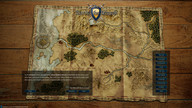EditingWesnoth/de
Um benutzerdefinierte Inhalte für Wesnoth zu erstellen, musst du wissen, wo sich die Ressourcen des Spiels befinden und wo du eigene Ressourcen einfügen kannst. Auf dieser Seite wird erläutert, wie du auf die vorhandenen Ressourcen des Hauptspiels (im Verzeichnis data) zugreifst und wie du neue, benutzerdefinierten Inhalte (im Verzeichnis userdata) einfügst.
Der einfachste Weg, die Spiel- und Benutzerdatenverzeichnisse zu finden, besteht darin, das Spiel zu starten und auf das „i“-Symbol in der unteren linken Ecke des Hauptmenüs zu klicken. Dadurch wird ein Dialogfeld mit vielfältigen Informationen aufgerufen, das u.a. auch die aktuellen Verzeichnispfade des Spiels anzeigt.
Von diesem Dialog aus ist es z.B. möglich, einen Verzeichnispfad in die Zwischenablage zu kopieren oder ein Verzeichnis mit dem Dateimanager deines Betriebssystems (unter Windows beispielsweise dem Explorer) zu öffnen.
Für weitere betriebssystemspezifische Informationen dazu siehe den Abschnitt weiter unten.
Contents
Die Spieldaten-Verzeichnisse
Es spielt keine Rolle, in welchem Verzeichnis das Spiel installiert wurde, es sind immer die Unterverzeichnisse data, sounds und images vorhanden. Die anderen vorhandenen Unterverzeichnisse sind eher für Entwickler interessant. Abgesehen von dem Verzeichnis data enthalten diese Verzeichnisse Daten, die das Spiel allgemein betreffen, und nicht etwa einzelne Szenarios und Kampagnen.
Im data-Verzeichnis finden sich unter anderem folgende Unterverzeichnisse: campaigns, multiplayer, core. Diese Verzeichnisse enthalten die Hauptkampagnen des Spiels, die Multiplayer-Karten und -Szenarios, sowie alle Ressourcen, die in den Erweiterungen verwendet werden.
Du solltest dir die Inhalte in den genannten Verzeichnissen anschauen, um eine Vorstellung davon zu bekommen, wie die in Wesnoth mitgelieferten Szenarios und Kampagnen aufgebaut sind. Im core-Verzeichnis gibt es ein
Inside the data folder you will find , among others, these folders: campaigns, multiplayer, core. These contain the mainline campaigns, the multiplayer maps and scenarios, and all the resources used in add-ons. You may examine the contents of the former for reference on how the campaigns and maps included in mainline are coded. In core, you will find another set of music, sounds, images directories. Look in here to find resources for creating your UMC content.
NOTE: These folders are NOT the place to put your own resources when creating an add-on. You should keep them in your add-on's folder the userdata directory, as detailed below.
In this wiki, the terms "game data", wesnoth/data, or ./data refer to the wesnoth/data directory. The terms "core folder" or core refer to the wesnoth/data/core directory.
Wie komme ich dorthin
Windows
- On 32-bit computers: C:\Program Files\Battle for Wesnoth <version>\data
- On 64-bit computers: C:\Program Files (x86)\Battle for Wesnoth <version>\data
Note: C refers to the partition or drive where Windows is installed. If your copy of Windows is not on C, or Wesnoth is installed in a different location, the path may not match those given above. If you don't remember where you installed the game, right click on the game's shortcut, open Properties, and click on the "Find target" button.
macOS
- Control+click on the application icon. Select "Show Package Contents", then navigate to "Contents" → "Resources".
Linux
- Custom builds: /usr/local/share/wesnoth
- Debian/Ubuntu packages, or emerge (Gentoo): /usr/share/games/wesnoth
- Red Hat Linux-based distributions in general (openSUSE, Fedora): /usr/share/wesnoth
- Arch Linux: /usr/share/wesnoth
- Mandriva: /usr/share/games/wesnoth
- Slackware Linux: /usr/local/share/wesnoth
In a terminal, the command wesnoth --path shows the game data directory.
BSD
- OpenBSD package: /usr/local/share/wesnoth
The command wesnoth --path also works.
The user data directory
The user data directory in particular is the most important to a content creator. Inside are your preferences file, custom maps, saved games, the WML cache and data files corresponding to user-created content. In this wiki, "user data" and userdata/ refer to this directory.
The game looks at the following paths for the respective content:
- userdata/data/add-ons - add-ons you have installed via the built-in add-on manager or are designing yourself
- userdata/editor - scenario and map files created via the in-game editor
- userdata/saves - the directory containing all your savegame files
- userdata/cache - the auto-generated game cache files
- userdata/preferences - plaintext file containing all your saved user preferences
Note: This may not be totally accurate for all systems, for my Linux system the preferences file is stored in ~/.config/wesnoth
The add-ons directory is particularly useful. In order to work with custom scenarios or campaigns, you will need to have your own add-on set up here. Instructions on how to do so can be found in AddonStructure. Several pages on this wiki will assume you have done so and refer to relative paths in such.
How to get there
Windows
- Documents\My Games\Wesnoth<version>
macOS
- Wesnoth 1.14.6 and later: ~/Library/Containers/org.wesnoth.Wesnoth/Data/Library/Application Support/Wesnoth_<version>
- Older versions: ~/Library/Application Support/Wesnoth_<version>
Note: The Library folder is hidden by default. You can press the Option key and choose Go to access it, or choose Go > Go to Folder… and type in the path there.
Linux
- ~/.local/share/wesnoth/<version>
- If installed via flatpak: ~/.var/app/org.wesnoth.Wesnoth/data/wesnoth/<version>
In a terminal, the command wesnoth --config-path shows the user data directory.
BSD
- Same place as Linux.
